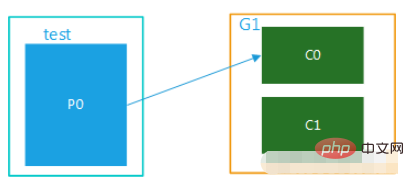
1. Install Kafka
- Download and install Apache Kafka on your server.
- Decompress the Kafka archive file.
- Set environment variables
KAFKA_HOMEis the Kafka installation directory.
2. Start ZooKeeper
- ZooKeeper is a dependency of Kafka, so it must be started before starting Kafka.
- Open a command line terminal and navigate to the
$KAFKA_HOME/bindirectory. - Run the following command to start ZooKeeper:
./zookeeper-server-start.sh config/zookeeper.properties
3. Start the Kafka server
- Open a command line terminal and navigate to
$KAFKA_HOME/binDirectory. - Run the following command to start the Kafka server:
./kafka-server-start.sh config/server.properties
4. Create a topic
- A topic is a logical grouping of data in Kafka .
- To create a theme, open a command line terminal and navigate to the
$KAFKA_HOME/bindirectory. - Run the following command to create a topic:
./kafka-topics.sh --create --topic my-topic --partitions 1 --replication-factor 1
5. Send a message
- To send a message to the topic, open the command Run Terminal and navigate to the
$KAFKA_HOME/bindirectory. - Run the following command to send a message:
./kafka-console-producer.sh --topic my-topic --message "Hello, world!"
6. Consume messages
- To consume messages from a topic, open the command Run Terminal and navigate to the
$KAFKA_HOME/bindirectory. - Run the following command to consume messages:
./kafka-console-consumer.sh --topic my-topic --from-beginning
7. Query the version
- To query the version of the Kafka server, please open Command line terminal and navigate to the
$KAFKA_HOME/bindirectory. - Run the following command to query the version:
./kafka-version.sh
Sample output
kafka-version.sh: version: 2.8.0 kafka-version: 2.8.0 kafka-storage: 2.8.0 kafka-clients: 2.8.0 kafka-streams: 2.8.0 kafka-connect: 2.8.0 kafka-admin: 2.8.0 kafka-tools: 2.8.0
The above is the detailed content of A step-by-step guide to learning to use Kafka version queries. For more information, please follow other related articles on the PHP Chinese website!
 springboot+kafka中@KafkaListener动态指定多个topic怎么实现May 20, 2023 pm 08:58 PM
springboot+kafka中@KafkaListener动态指定多个topic怎么实现May 20, 2023 pm 08:58 PM说明本项目为springboot+kafak的整合项目,故其用了springboot中对kafak的消费注解@KafkaListener首先,application.properties中配置用逗号隔开的多个topic。方法:利用Spring的SpEl表达式,将topics配置为:@KafkaListener(topics=“#{’${topics}’.split(’,’)}”)运行程序,console打印的效果如下
 如何使用PHP和Kafka实现实时股票分析Jun 28, 2023 am 10:04 AM
如何使用PHP和Kafka实现实时股票分析Jun 28, 2023 am 10:04 AM随着互联网和科技的发展,数字化投资已成为人们越来越关注的话题。很多投资者不断探索和研究投资策略,希望能够获得更高的投资回报率。股票交易中,实时的股票分析对决策非常重要,其中使用Kafka实时消息队列和PHP技术实现更是一种高效且实用的手段。一、Kafka介绍Kafka是由LinkedIn公司开发的一个高吞吐量的分布式发布、订阅消息系统。Kafka的主要特点是
 SpringBoot怎么集成Kafka配置工具类May 12, 2023 pm 09:58 PM
SpringBoot怎么集成Kafka配置工具类May 12, 2023 pm 09:58 PMspring-kafka是基于java版的kafkaclient与spring的集成,提供了KafkaTemplate,封装了各种方法,方便操作,它封装了apache的kafka-client,不需要再导入client依赖org.springframework.kafkaspring-kafkaYML配置kafka:#bootstrap-servers:server1:9092,server2:9093#kafka开发地址,#生产者配置producer:#Kafka提供的序列化和反序列化类key
 kafka可视化工具对比分析:如何选择最合适的工具?Jan 05, 2024 pm 12:15 PM
kafka可视化工具对比分析:如何选择最合适的工具?Jan 05, 2024 pm 12:15 PM如何选择合适的Kafka可视化工具?五款工具对比分析引言:Kafka是一种高性能、高吞吐量的分布式消息队列系统,被广泛应用于大数据领域。随着Kafka的流行,越来越多的企业和开发者需要一个可视化工具来方便地监控和管理Kafka集群。本文将介绍五款常用的Kafka可视化工具,并对比它们的特点和功能,帮助读者选择适合自己需求的工具。一、KafkaManager
 go-zero与Kafka+Avro的实践:构建高性能的交互式数据处理系统Jun 23, 2023 am 09:04 AM
go-zero与Kafka+Avro的实践:构建高性能的交互式数据处理系统Jun 23, 2023 am 09:04 AM近年来,随着大数据的兴起和活跃的开源社区,越来越多的企业开始寻找高性能的交互式数据处理系统来满足日益增长的数据需求。在这场技术升级的浪潮中,go-zero和Kafka+Avro被越来越多的企业所关注和采用。go-zero是一款基于Golang语言开发的微服务框架,具有高性能、易用、易扩展、易维护等特点,旨在帮助企业快速构建高效的微服务应用系统。它的快速成长得
 springboot项目配置多个kafka的示例代码May 14, 2023 pm 12:28 PM
springboot项目配置多个kafka的示例代码May 14, 2023 pm 12:28 PM1.spring-kafkaorg.springframework.kafkaspring-kafka1.3.5.RELEASE2.配置文件相关信息kafka.bootstrap-servers=localhost:9092kafka.consumer.group.id=20230321#可以并发消费的线程数(通常与partition数量一致)kafka.consumer.concurrency=10kafka.consumer.enable.auto.commit=falsekafka.boo
 从面试角度一文学完 KafkaAug 24, 2023 pm 03:22 PM
从面试角度一文学完 KafkaAug 24, 2023 pm 03:22 PMKafka 是一个优秀的分布式消息中间件,许多系统中都会使用到 Kafka 来做消息通信。对分布式消息系统的了解和使用几乎成为一个后台开发人员必备的技能。
 go-zero与Kafka的应用实践:构建高并发、高可靠性的消息系统Jun 23, 2023 am 09:40 AM
go-zero与Kafka的应用实践:构建高并发、高可靠性的消息系统Jun 23, 2023 am 09:40 AM随着互联网的不断发展,对于消息系统的需求也越来越高。在构建高并发、高可靠性的消息系统中,go-zero和Kafka是两个非常好的选择。go-zero是一个基于Go语言的微服务框架,通过简单易用、高性能、可扩展等特点,在很多领域被广泛应用。Kafka是一个开源的分布式流媒体平台,具有高可靠性、高吞吐量、易拓展等特点,在处理大规模数据流和实时数据管道方面得到广泛


Hot AI Tools

Undresser.AI Undress
AI-powered app for creating realistic nude photos

AI Clothes Remover
Online AI tool for removing clothes from photos.

Undress AI Tool
Undress images for free

Clothoff.io
AI clothes remover

AI Hentai Generator
Generate AI Hentai for free.

Hot Article

Hot Tools

SAP NetWeaver Server Adapter for Eclipse
Integrate Eclipse with SAP NetWeaver application server.

Dreamweaver Mac version
Visual web development tools

ZendStudio 13.5.1 Mac
Powerful PHP integrated development environment

Atom editor mac version download
The most popular open source editor

SublimeText3 Linux new version
SublimeText3 Linux latest version






